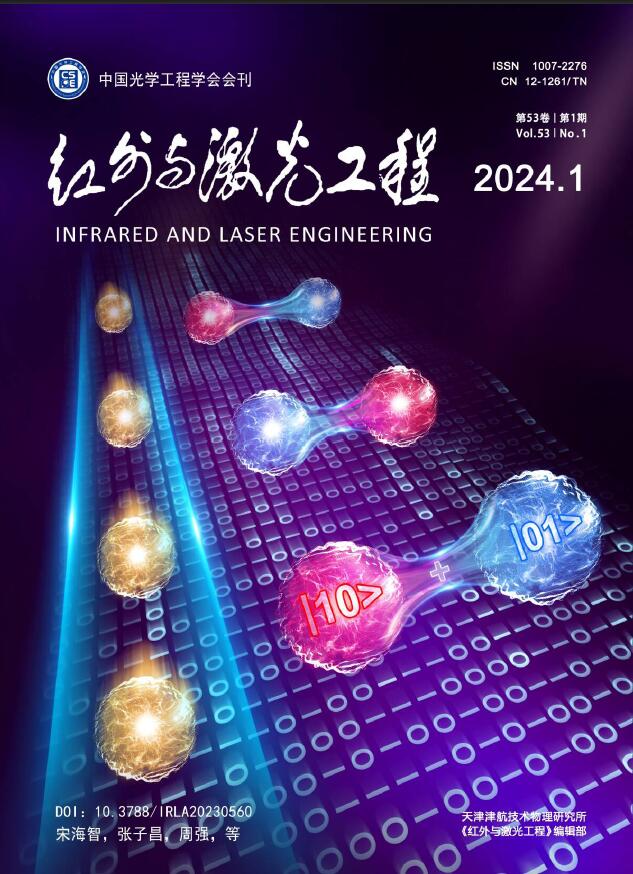-
全固态单频连续波1064 nm激光器由于其噪声低、线宽窄、光束质量好、功率稳定性高等优点,被广泛应用于制备新型激光光源、产生非经典光场、研究冷原子物理以及探测引力波等领域。然而在很长一段时间里,这些领域所使用的连续单频1064 nm激光器一直处于中低功率段。随着引力波测量、冷原子物理、量子网络以及单频中红外激光光源的研制等科学研究领域的不断发展和深入,人们对连续单频1064 nm激光器提出了要求,包括激光器在具有高输出功率的同时,要有较低的强度噪声、较好的光束质量以及较高的功率稳定性和频率稳定性。例如在引力波测量[1]以及超声速风洞非接触测量[2]等精密测量的实验中,提高单频激光器的输出功率和降低单频激光器的强度噪声可以提高整个测量系统的信噪比,进而提高干涉装置的测量精度。在冷原子物理中[3],提高连续单频1064 nm激光器的输出功率和降低连续单频1064 nm激光器的强度噪声可获取稳定运转的高势垒光阱进而制备高质量的光学晶格,从而为冷原子物理研究的发展提供重要的技术手段。在量子网络的研究中,高功率低噪声的单频连续波激光器可同时泵浦多个光学参量放大器(Optical Parameter Amp-lifier, OPA),进而获得多组份纠缠态[4],而多组份纠缠态是进行构建量子网络的重要技术基础[5]。高输出功率的连续单频1064 nm激光器还可通过腔内或腔外倍频技术获得高功率高光束质量的连续单频532 nm激光器,为连续单频钛宝石激光器[6]或超快激光[7]提供优质的泵浦光源;同时,高输出功率的连续单频1064 nm激光器可直接作为泵浦光源泵浦光学参量振荡器(Optical Parameter Oscillator, OPO)[8]产生1.5~5 μm中红外激光,为光纤通信、光谱探测以及光电对抗等提供可靠的中红外激光光源[9]。
为获得单频激光输出,需要对谐振腔内的模式进行选择。常见的选模技术[10]有短腔法、F-P标准具法、单向环形腔法、扭摆腔模法以及体布拉格光栅法等,以上技术通常需要使激光器工作在阈值附近或者一定功率范围内,导致获得的单纵模激光束输出功率较低。上述方法中,除有报道称采用磁场中的非平面环形谐振腔可以获得功率高达10.5 W的激光输出外[11],其余方法的输出功率通常难以突破瓦级。
尽管目前单频光纤激光器凭借着紧凑的结构、良好的光束质量、kHz量级的激光线宽以及方便高效的热管控等优势被广泛应用,然而其噪声特性限制了其在诸如高精度光谱学、精密时频传递、光泵磁力仪以及引力波探测等精密激光领域的进一步发展[12]。此外在使用光纤实现高功率激光操作时还需要面对受激布里渊散射(SBS)、受激拉曼散射(SRS)等非线性效应以及布拉格光栅的损伤阈值的问题。因此单频光纤激光器无法取代噪声相对更低的全固态单频连续波激光器。目前,要想获得输出功率达百瓦量级的高质量连续波单频1064 nm激光器,到目前为止主要采用的是激光放大技术。激光放大器可以是薄片式、板条式、光纤式和固体式。相对于薄片和板条以及光纤激光放大器而言,固体激光放大器更容易获得低噪声高光束质量的连续单频激光输出[13]。2005年,日本的Takeno等[14]在NPRO(Nonplanar Ring Oscillator)作为种子源的基础上,采用侧面泵浦的方式,通过注入锁定激光放大技术将2 W种子激光的输出功率放大到100 W。在他们的实验装置中,为了获得百瓦级的输出功率,他们采用了两组能实现热致退偏补偿的Nd: YAG作为激光放大介质,每组又由两块Nd: YAG晶体和90º旋光片组成。2008年,德国的Willke等[15]用NPRO作为种子源,经固体激光放大器放大,连续单频1064 nm激光的输出功率被放大到220 W。在该装置中,由于种子源激光器NPRO的输出功率只有2 W,因此,他们不得不先采用四级主振荡功率放大装置(Main Oscillator Power Amplifier, MOPA)将单频激光的输出功率放大到35 W[16]。随后,通过注入锁定的激光放大技术以及端面泵浦方式,在采用四块Nd: YAG增益晶体的条件下,连续单频1064 nm激光的输出功率高达220 W。该装置由于采用前后两种放大装置,因此激光器系统体积非常庞大。此外,为了提高整个系统的稳定性和输出激光的质量,他们不得不采用一系列的反馈控制系统对种子光和放大器之间进行锁定;而为了提高放大后输出激光的光束质量以及降低其强度噪声,他们又不得不采用光学模式清洁器来过滤放大激光的强度噪声和空间模式,从而使得整个激光器系统更加复杂。另外一种有效的办法是通过大幅度增大激光器的泵浦功率来获得结构紧凑、集成度高的实用化高功率全固态单频连续波激光器。然而,随着泵浦功率的增加,激光器内增益增大,谐振腔中的模式竞争加剧,导致激光器出现严重的多模和跳模现象,增大了激光器的噪声,影响了激光器的输出稳定性。为解决该问题,传统的方法是在谐振腔内插入标准具等元件进行选模,然而标准具在增大次模损耗的同时,也会增大主振荡模的损耗,进而限制了激光器的输出功率。另外,为了获得稳定运转的单纵模激光器,还需要采用额外的反馈控制装置对标准具进行锁定,这又增加了激光器的复杂度。1997年,K. I. Martin等人[17] 在研究可调谐激光器时发现,在谐振腔内插入倍频晶体后,通过扫描激光器谐振腔的腔长,激光器可以无跳模地实现多于80个纵模的频率调谐范围。这项工作表明,在谐振腔内引入非线性损耗可以有效地抑制次模的起振,这为研究和发展高功率全固态单频连续波激光器奠定了理论基础。作为一种重要的选模方式,在谐振腔中引入非线性损耗也可以使钛宝石激光器[18]、光参量振荡器[8]和拉曼激光器[19]实现单频运转。
文中详细综述了通过在谐振腔中引入非线性损耗来提高全固态单频激光器的输出功率的方式方法。首先介绍了非线性损耗在激光器中进行选模的基本原理以及谐振腔中实现单纵模运转的物理条件,进而介绍了一种精确测量腔内线性损耗的方法,这为提高全固态单频连续波激光器的输出功率提供了重要的理论依据。在此基础上,通过在谐振腔内插入多块增益晶体,有效分担了单块晶体上严重的热负荷,从而允许在谐振腔内注入更高的泵浦功率。在此基础上,介绍了百瓦级单频激光输出的代表性应用案和最新的研究进展。
-
在激光器的谐振腔中插入一块非线性晶体,当不同的纵模和非线性晶体相互作用时,不仅有各自的倍频过程,而且有纵模之间的和频过程。假如谐振腔中有两个相邻的纵模,这两个纵模的频率为$ {\omega }_{1} $和$ {\omega }_{2} $,对应光强分别为$ I\left({\omega }_{1}\right) $和$ I\left({\omega }_{2}\right) $,当这两个模式和倍频晶体相互作用时,产生总的倍频光功率可以表示如下:
其中,对于$ {\omega }_{1} $和$ {\omega }_{2} $而言,各自经受的非线性损耗为:
式中:k为非线性转化系数。则各纵模所经受的相对非线性损耗为:
式中:$ i=\mathrm{1,2} $。 这样,频率为$ {\omega }_{1} $和$ {\omega }_{2} $的两纵模的相对损耗分别为:
假设在模式竞争的作用下,$ {\omega }_{1} $的增益远大于$ {\omega }_{2} $,即$ I\left({\omega }_{1}\right)\gg I\left({\omega }_{2}\right) $,则有:
即谐振腔内主振荡模所经受的非线性损耗是次振荡模的一半,在模式竞争的作用下,次模将被自动抑制,因此激光器将以稳定的单纵模方式运转。
-
通过分析谐振腔内各个模式的运转情况可知,谐振腔中每个振荡的模式具有相等的线性损耗,当激光谐振腔内有非线性转化过程时,除了线性损耗,还存在有倍频以及和频引起的非线性损耗。要想使激光器实现单纵模稳定运转,则主振荡模式的净增益等于零,而次振荡模式的净增益则必须小于零。根据线性损耗和非线性损耗之间的关系,可以得出激光器单模运转的物理条件[20]:
式中:$ \gamma=\Delta \lambda_{N L} / \Delta \lambda_g$表示非线性晶体非线性谱宽和增益晶体的增益带宽的比值;$ {\alpha }_{0} $和$ {\varepsilon }_{0} $分别为归一化的线性损耗和非线性损耗;谐振腔的线性损耗为$ {\alpha }_{0}=(L+t)/2{g}_{0}l $,$ L $为腔内线性损耗,$ t $为输出镜的透射率,$ {g}_{0} $为小信号增益,$ l $为激光晶体的长度;谐振腔的非线性损耗为$ \varepsilon_0=k I_0 /\left(4 g_0 l\right)$,$ k $为非线性转换系数,$ I_0$为饱和功率。
基于提出的物理条件,将一块非线性LBO晶体插入如图1所示的四镜环形谐振腔内达到引入非线性损耗的目的。LBO晶体尺寸为3 mm×3 mm×18 mm,采用I类温度匹配,被放置在工作温度为149 ℃,控制精度为0.1 ℃的控温炉中。根据公式(6)得到的图2,即表示激光器可以实现单纵模运转的物理条件。其中,左上角区域为单纵模区域,右下角为多纵模区域。从图中可以看出,通过在谐振腔内引入适当的非线性损耗以及线性损耗即可获得一个很宽的单纵模区域,实现激光器的单纵模激光输出。
在实验中,当非线性晶体没有插入谐振腔时,通过扫描共焦F-P干涉仪,可以看到激光器同时有三个纵模起振,如图3(a)所示。而当LBO插入谐振腔内并工作在最佳相位匹配温度后,输出耦合镜的透射率分别为HR、16%、19%时,激光器都可以稳定地以单纵模方式运转,如图3(b)所示。而当输出耦合镜的透射率为22%时,由于谐振腔内基频光强度较低,使得由非线性过程引入的非线性损耗较小,导致激光器不能满足公式所示的单纵模运转的物理条件,最终,激光器不能以稳定的单纵模方式运转。将激光器的相关参数代入公式(6)中,可以从图2(实验点)中很清楚地看到,当透射率低于19%,激光器均运转在单纵模区域。而当输出耦合镜的透射率高于19%后,激光器就工作在单纵模区域以外。最后,当输出耦合镜的透射率为19%时,获得了输出功率为33.7 W的连续单频1064 nm激光器,同时有1.13 W的连续单频532 nm激光输出,总的光光转化效率高达46.5%。
-
为实现高质量的高功率单频连续波激光器,需要对激光器内的往返损耗进行精确测量。腔内往返损耗与净增益之间的关系是决定激光器运行状态的主要因素,精确测量这一损耗对于在实验上实现稳定高效运转的高功率激光器来说至关重要,因为它对泵浦阈值功率和激光器的输出功率有着深远的影响。1996年,Findlay和Clay提出了一种通过测量不同透射率的输出耦合镜下对应的阈值泵浦功率,进而推算出腔内往返损耗的方法[21]。然而这种方法操作繁琐,且误差较大。2008年,Song 等人提出一种将泵浦光功率带入速率方程并进行数值拟合的方法来得到腔内损耗的方法[22],但是此方法在高功率激光器中不适用。2012年,笔者课题组也曾提出过一种通过测量弛豫振荡频率和输出功率得出腔内损耗的方法[23],然而此方法无法被应用到高增益激光器中。针对此,笔者在利用非线性损耗实现激光器单频运转的基础上,通过操控非线性损耗的大小,提出了一种简便高效,且适用于高功率激光器的腔内(线性)损耗测量方法[24]。
当非线性损耗被引入谐振腔后,单频激光器可以实现双波长激光输出,此时激光器内的往返损耗可以进一步细分为线性损耗和非线性损耗。实验中可以通过调整非线性晶体LBO的相位匹配温度对谐振腔内的非线性损耗的大小进行调整,进而影响激光器的输出特性。通过精确测量不同情况下的基频光和倍频光的输出功率,即可反推出谐振腔内线性损耗的大小,从而得出激光器内的往返损耗。激光器中基频光和倍频光的输出功率分别可表示为[24]:
基频光的强度表达式为:
式中:$ {P}_{f} $和$ {P}_{sh} $分别表示基频光和倍频光的输出功率;$ A $为增益介质处的激光横截面积;$ t $为输出耦合镜的透射率;$ \eta $为非线性转化因子;$ {I}_{0} $为饱和强度。另外,对于运转稳定的激光器而言,$ {g}_{0}l=K{P}_{in} $,其中$ {g}_{0} $为小信号增益;$ l $为增益晶体长度;K为泵浦光转化因子;Pin为泵浦光的功率。将公式(9)代入公式(7)和(8)可以得到腔内线性损耗的表达式:
在公式(10)中,除腔内线性损耗L与泵浦光转化因子K外,其余均为已知量或可测量,即公式(10)是关于谐振腔的腔内线性损耗L以及泵浦光转化因子K的二元一次方程。在激光器输出耦合镜透射率一定的条件下,只改变非线性转化效率的大小,就可以调控基频光和倍频光的输出功率。换言之,只要精确测量不同非线性转化效率下的基频光和倍频光的输出功率并代入公式(10)中,就可以得到一组关于腔内线性损耗L与泵浦光转化因子K的二元一次方程组。通过对该方程组进行求解即可得出泵浦光转化因子和腔内线性损耗的大小。
基于图1的实验装置,在输出耦合镜的透射率为20%的情况下,通过改变非线性晶体LBO的相位匹配温度可以改变谐振腔输出基频光和倍频光的功率。输出功率随温度的变化情况如图4所示。通过记录激光器在单频运转区域内6个采样点的数据,可以得到6个关于线性损耗和泵浦因子的二元一次方程;通过将每两个方程进行组合并求解,可以解出15组对应的腔内线性损耗L和泵浦因子K,对其求平均值和标准差可以得到,实验中的激光器的腔内线性损耗L为(4.84±0.26)%,泵浦因子K为(6.91±0.07)% W−1。
在精确测量激光器腔内线性损耗的基础上,结合腔内增益与损耗的数据设计并实现了一款高功率全固态单频连续波1064 nm激光器[25]。在设计过程中,除重点分析激光器的增益和损耗外,还结合了直接泵浦、复合晶体、像散自补偿以及非线性损耗等技术。在各方面优化下,通过将激光器的泵浦功率提高到113 W,输出耦合镜的透射率优化为25%,该激光器的最高输出功率高达50.3 W,激光器的输出功率曲线如图5所示。在增加泵浦功率的过程中,由于晶体的热透镜焦距在不断变化导致晶体处的模式匹配效率也在变化,因此输出功率并不随着泵浦功率的增加而线性增加。与此同时,由于非线性晶体的存在,同时产生了1.9 W的单频532 nm激光输出,总的光光转换效率为46.2%。激光器在5 h范围内的峰值功率稳定性为±0.54%。激光器的模式结构如图6所示,通过监测输出激光的横模与纵模可得,在最大输出功率处,X方向和Y方向的光束质量分别为1.08和1.10,通过一个精细度为210,自由光谱区为750 MHz的F-P干涉仪监测可得激光器处于稳定的单纵模运转状态。该激光器后续被应用于研究纵模结构与相对噪声强度之间的关系,以及作为高质量注入锁定激光器以及MOPA结构的种子源激光器。
-
在插有单块增益介质的光学谐振腔中,激光器输出功率的提升受增益晶体的热效应以及晶体的光学损伤阈值的限制。通过在单个环形谐振腔内插入多块串接增益晶体,每块增益晶体单独由激光二极管进行泵浦,能够有效克服单块晶体在高功率泵浦时由热效应导致激光器稳区变窄的现象以及单块晶体损伤阈值对输出功率的限制,从而大幅度提高激光器的输出功率。但是在单个谐振腔中采用多晶体串接技术实现高功率连续波单频激光器的过程中,不仅需要考虑环形谐振腔在高功率运转时的单向问题,而且需要考虑每块增益晶体处的模式匹配问题和增益晶体之间的模式自再现问题。在2018年,笔者课题组通过设计并搭建了如图7所示的激光谐振腔,实现了输出功率高于100 W的单频激光输出[26]。
在单个谐振腔内插入参数相同的两块增益Nd:YVO4晶体时,为了实现精确的模式自再现,两块晶体之间插入由两个透镜组成的像传输系统进行模式变换。同时,为了减小光学单向器中磁致旋光晶体的热效应对激光器输出功率的限制,选用了磁旋光系数更大、吸收系数更低的TSAG晶体代替了传统的TGG晶体。通过调整组成像传输系统的两块透镜之间的距离,激光器的工作稳区也随之变化。实验中,通过不断优化组成像传输系统的两透镜之间的距离实现了最佳的模式配。在非线性晶体LBO处于最佳相位匹配温度149 ℃,注入泵浦功率为240 W的情况下得到了功率为(101.00±1.00) W的单频1064 nm激光输出, 同时产生了(1.91±0.02) W的单频532 nm激光。1064 nm激光器的阈值为(96.12±0.96) W。激光器总的光-光转换效率为42.3%。激光器的输出功率曲线以及横模结构如图8所示,其中激光器的光束质量因子M2≤1.18。在最高输出功率101 W时测量其8 小时内功率的峰-峰值和均方根值的波动性分别优于±0.73%和0.17%,激光器的纵模结构和长期功率稳定性如图9所示。利用非零拍自外差法基于25 km延时光纤测量的101 W单频连续波1064 nm激光器的线宽为365 kHz,如图10所示。
-
为了进一步提升全固态单频连续波激光器的输出功率,设计并搭建了如图11 所示的包含4个独立泵浦的Nd: YVO4激光增益晶体的激光谐振腔[27],其中每个激光晶体既是增益介质,又是模式匹配元件。通过分别操控每个增益晶体的泵浦功率,实现激光谐振腔的最佳自模式匹配后,获得了输出功率高达140 W的连续波单频激光输出。
通过理论计算在不同泵浦情况下晶体处的腔模半径,可以得到图12所示的关系图。由于腔的对称性,在P2与P4分别等于P1与P3的情况下,图11中Nd1和Nd3处光斑分别与Nd2和Nd4的光斑相等。由图12可知,在不同的泵浦方案下,激光器的稳区以及晶体处的光斑大小也将不同,即激光器的工作特点不同。在特定情况下激光器还将会出现双稳区的现象,如图12(a)、图12(b)中的情况。当单端泵浦功率在约35 W到约70 W的范围之间时,理论计算得出的晶体处光斑半径发散,说明此工作状态下没有稳区。当泵浦功率进一步提高时,激光器重新进入稳区。据此推测实验中随着泵浦功率的增加,激光器会有不出光的工作状态。在此过程中,泵浦功率将全部转化为热从而导致晶体内部的温度快速增加,晶体热透镜效应加剧,因此激光器将很快进入第二个稳区甚至出现两个稳区相连的情况。此时,激光器的输出功率可能并不会随着泵浦功率的增加而增加。为避免激光晶体损坏,实验过程中当腔处在理论计算的两个稳区之间时,会增大泵浦光的增加速率。

Figure 12. Theoretical predictions of the mode size variations at the positions of the four laser crystals dependence on incident pump powers (P1, P2, P3, P4). (a) and (b) Incident pump powers of four laser crystals are synchronously increased; (c) and (d) Increasing the incident power of P3 and P4 when P1 and P2 are fixed at 70 W, 83 W, 90 W, 103 W and 110 W; (e) and (f) Increasing the incident power of P1 and P2 when P3 and P4 are fixed at 70 W, 83 W, 90 W, 103 W and 110 W
通过精确调整谐振腔内每块激光增益晶体上注入的泵浦功率,进而调整每块增益晶体的热透镜焦距,谐振腔实现了良好的自模式匹配。当非线性晶体LBO处于148 ℃时,激光器在375.4 W的总泵浦功率下实现了140 W的单频激光输出。实验中获得的激光器的输出功率曲线如图13所示,其中不同曲线对应不同的泵浦方案,泵浦方案在图13左上角标出。通过图13中蓝色圆点和蓝色三角形连接的曲线可以研究通过调整入射泵浦功率对所构建激光器的输出特性造成的影响。当P1~P4的泵浦光功率分别为降低至52.5 W、52.5 W、106 W和99.7 W时,激光器由于不在稳区内运行因此不输出1064 nm激光,如图13中点A所示。继续降低P3和P4的泵浦功率使激光器由于重新进入稳区可以立刻重新出光,如图13中点B所示。这一实验现象说明所搭建的腔型中确实有双稳区的现象。此外,在图13中,红色五角星、蓝色三角形和蓝色圆圈所对应的功率曲线里均出现了随泵浦功率的增加,激光器的输出功率下降的情况,这与理论分析中的预测内容完全一致。同时,在增加泵浦功率和降低泵浦功率的过程中,也可以发现明显的类双稳现象,这说明尽管采用了吸收系数更小的TSAG晶体作为单向器中的磁致旋光晶体,但是由于腔内功率密度较高,其仍然会具有一定的热透镜效应,进而影响激光器的输出状态。由于非线性过程的存在,激光器也同时产生了532 nm激光输出。在最高输出功率下对激光器的输出特性进行了测量,测量结果如图14所示。激光器在5 h范围内的峰峰值功率稳定性优于±1.1%,与此同时,通过监测输出激光的纵模结构发现激光器处于稳定的单纵模运转。得益于LBO提供了足够的非线性损耗以及自模式匹配的实现,此谐振腔的单纵模运转区域非常宽。利用光束质量分析仪测量了激光器的横模特性,输出激光的光束质量因子在x方向和y方向上分别为Mx2=1.23以及My2=1.21。利用25 km延时光纤通过非零拍自外差法测量的140 W单频连续波1064 nm激光器的线宽为102 kHz,这是因为谐振腔的总长度较长,约为1.7 m。通过对激光器的相对强度噪声进行测量发现,激光器在2.1 MHz处达到了量子噪声极限。

Figure 14. Measured output performances of 1064 nm laser. (a) The stability of output power over 5 h (Insert: Longitudinal-mode structure); (b) Transverse mode structure characteristic; (c) Linewidth; (d) Relative intensity noise spectrum
输出功率高达140 W的全固态单频连续波激光器的成功实现表明,通过在谐振腔内引入非线性损耗可以使激光器在更高的腔内增益下保持稳定的单纵模运转。在此基础上,通过与谐振腔内插入多块激光增益晶体的技术相结合,可以实现在保持全固态单频连续波激光器优异输出特性的同时,大幅度提升激光器的输出功率。这些结果为未来实现更高功率的激光输出奠定了基础。
-
文中主要总结了在全固态单频连续波激光器中,通过在谐振腔内引入非线性损耗提高全固态单频连续波激光输出的方式方法。通过与谐振腔中插入多块激光增益晶体的技术结合,笔者成功实现了百瓦级的激光输出。首先介绍了全固态单频连续波激光器的特点以及发展趋势,并提出了在保证全固态连续波激光器优异的整体性能的前提下进一步提高激光器输出功率的必要性。然后分别介绍了利用非线性损耗进行选模的基本原理以及激光器单频运转的物理条件,在此基础上进一步介绍了通过利用非线性损耗精确测量激光器内线性损耗的原理和方法。在上述理论的指导下,通过与腔内插入多块激光增益晶体的技术相结合,课题组实现了百瓦级的连续波单频激光输出,是国际最高水平。通过在谐振腔中引入非线性损耗,全固态单频连续波激光器可以在更高功率下实现高质量的单频激光输出的同时,其应用范围也在不断推广,这对推动全固态单频连续波激光器本身以及相关领域的发展有着非常重要的科学意义。
Research progress on enhancing the output power of all-solid-state single-frequency continuous-wave lasers by using intracavity nonlinear loss mode-selecting technology (invited)
doi: 10.3788/IRLA20230592
- Received Date: 2023-10-26
- Rev Recd Date: 2023-11-23
- Publish Date: 2024-01-25
-
Key words:
- all-solid-state laser /
- nonlinear loss /
- single frequency /
- high power
Abstract:






















 DownLoad:
DownLoad:












